
I was given a rare opportunity to tour the
Valley Forge Military Academy in Wayne, PA. The all boys boarding school and junior college is best known as the location where the movie
Taps was filmed.

One of my co-workers attended this school for six years and was given a nice alumnus welcome.
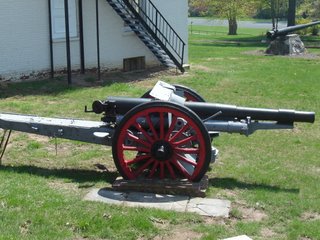
According to
Wikipedia:
Valley Forge Military Academy was founded in 1928 by Lieutenant General Milton G. Baker at a location several miles away from the campus' current location. After a fire devastated the original single-building campus, the Academy was moved to its present site in Wayne. Baker, an Anglophile, modeled many of the Academy's drills, customs, and ceremonies after a British model. The Academy still maintains loyalty to this tradition. Many graduates go on to own their own businesses

We arrived just in time for the daily inspection of the 500 cadets in grades seven through post-graduate.

Kids, mostly of high school age, marched in formation.

They groups were apparently divided into "companies". These groups dormed together and probably took a lot of the same classes.
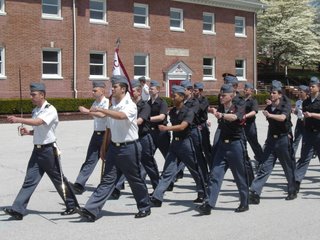
The leaders appeared to all have swords.

Some cadets served as an honor guard of sorts.

They lined up for inspection. Permission to approve it was granted, and the kids went on with their day.

It is a beautiful campus and is deeply rooted in tradition. Cadets have a pretty strict schedule and are given a six week orientation before classes start.

I'm a sucker for libraries, so I had to walk through to see what kind of books they had.

It is an extremely orderly and well maintained place.

The books, however, are quite old. Many of them are from the 40s and 50s. You don't have too many books coming out today titled "Great American Negroes". Yet for books that were almost 50 years old at time, they were incredibly well maintained. The school librarians did a great job and clearly the students had a respect for the books held inside.

Kids from all over the world attend the school, and the countries represented are honored with flags in one of the campus' halls. No one from Greece or Ireland appears to be at the school right now.

This is Eisenhower Hall, which houses the school's senior administrators. It is also the backdrop of some of the scenes in Taps.

Graduation ceremonies take place here.

President Dwight Eisenhower is revered at the school, and plaque where he once stood is on display.
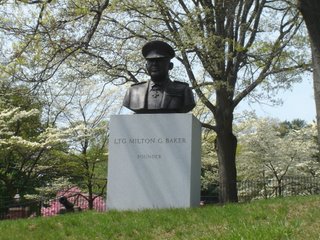
General Baker, the school's founder, is also honored.

The campus has a number of meeting rooms for public speeches and events for the students.

This dining hall is part of the Eisenhower complex.

It gives you a good view of the graduation area.

As you would imagine from a military academy, the dorms are Spartan, with blue and white hallways and simple beds.

The academy has a small museum that shows the history of the place. Here is a uniform used from the movie Taps.

Also on display is an old-style closet area for the cadets. Each student was required to carefully maintain this area.

The style for formal wear has changed over the years.

The time of a cadet is carefully guarded. Here is a "leave permit" from long ago so that G.J. Supplee could go see a movie.

The part from Taps I most remember is the chapel and a scene where actor George C. Scott reads the names of students who died for their country.

The chapel is as I remembered it from the film.

Stained glass windows show scenes of military and state history.

Students who have died are honored by a statue...
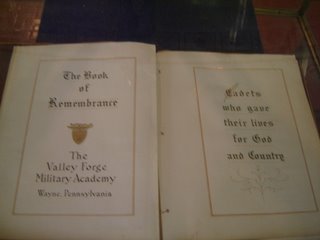
...a book...

...and for some administrators, a plaque.

George C. Scott was here!

So was Larry Fitzgerald, now of the Arizona Cardinals. Other
famous graduates include J.D. Salinger, author, "Catcher in the Rye", Norman Schwarzkopf, Centcom Commander, Operation Desert Storm, Edward Albee, American playwright, Warren B. Rudman, United States Senator, R-New Hampshire, and Aaron Beasley, NFL player, New York Jets, Atlanta Falcons.
It was a nice, random thing to do. It's a nice place to visit, but I don't think I would have been able to go here. I would have been on KP duty all the time.
 I have recently been driving through rural Pennsylvania and found myself at First Energy Stadium in Reading, PA, and Clipper Magazine Stadium in Lancaster, PA.
I have recently been driving through rural Pennsylvania and found myself at First Energy Stadium in Reading, PA, and Clipper Magazine Stadium in Lancaster, PA. Both stadiums seem to be part of a plan to revitalize urban centers which have been hurt by the onslaught of suburban life. The stadiums are quite ornate, and there's a lot to do in addition to watching baseball.
Both stadiums seem to be part of a plan to revitalize urban centers which have been hurt by the onslaught of suburban life. The stadiums are quite ornate, and there's a lot to do in addition to watching baseball. Baseball is the main event though, and here you will see a member of the Reading Phillies go up to the plate.
Baseball is the main event though, and here you will see a member of the Reading Phillies go up to the plate. Ticket sales seemed to be pretty good, and the Reading ballpark was small enough that almost all of the seats were good ones.
Ticket sales seemed to be pretty good, and the Reading ballpark was small enough that almost all of the seats were good ones. Local Reading businesses seemed to rally behind the place, judging by all of the ads at the home run wall.
Local Reading businesses seemed to rally behind the place, judging by all of the ads at the home run wall.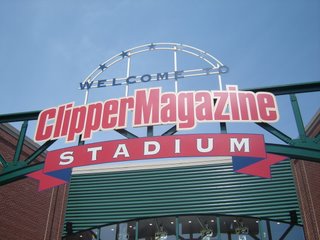 Clipper Magazine Stadium in Lancaster, PA also had a positive and friendly vibe to it. They also seemed to take extra care in having non-baseball things to do.
Clipper Magazine Stadium in Lancaster, PA also had a positive and friendly vibe to it. They also seemed to take extra care in having non-baseball things to do. They even had a Ferris wheel. How cool is that? Shea Stadium really needs one of them, that way kid can play while the Mets blow big leads in the ninth inning when they play a closer who sucks.
They even had a Ferris wheel. How cool is that? Shea Stadium really needs one of them, that way kid can play while the Mets blow big leads in the ninth inning when they play a closer who sucks. Minor league parks give you a close seat to the action that you really cannot cheaply get in a major league atmosphere. Also, things like steroids do not appear to be visible, although I imagine they are part of the small town game as well.
Minor league parks give you a close seat to the action that you really cannot cheaply get in a major league atmosphere. Also, things like steroids do not appear to be visible, although I imagine they are part of the small town game as well.


















































